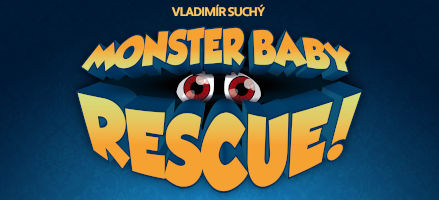
Monster Baby Rescue
A magic portal opens on Maple Avenue, and suddenly monsters are running through your neighborhood. But these are little monsters – just babies, really.
They are certainly not big enough to take care of themselves. They need to go back to their own world, but no one knows how to send them home.
You can help. While the Police Department tries to figure out how to reopen the magic portal, you can let one of these sad,
malnourished monsters live with you. With love and care, you will be able to send your monster home happy and healthy.
Monster Baby Rescue is a family game – it is simple enough for kids to play, but it offers sophisticated strategic opportunities that will keep adult board gamers engaged.
Each player starts the game with a sad, scared baby monster. Players take turns choosing tiles representing different ways of caring for their foundling. Taking a tile costs
a variable amount of time, and players must weigh the benefits of a tile against the amount of time it will cost.
As the monsters get more care, they become healthier and happier. At the end of the game, the winner is the player whose monster has received the best care.
Components
68
4
10
12
diamond gems, 6 red and 6 green
5
monster sets
5
cardboard monster figures, each with its own plastic stand
5
1
1
1
forbidden path marker
5
thirty-points scoring markers
1
rulebook
Setup

-
Set the main board in the middle of the table. The side with the timing track should be face up.
-
Go through the monster care deck and remove tiles to make it the correct size for the number of players in the game. A 5-player game will use all the tiles.
In a 4-player game, remove all tiles marked 5. In a 3-player game, remove all tiles marked 5 or 4+. In a 2-player game, remove all tiles marked 5, 4+, or 3+.
Shuffle the monster care deck and place it next to the main board.
-
Place the tile row next to the main board. Deal the top 6 care tiles to the tile row. If necessary, rearrange the tiles as follows: Tiles with no hearts should be down,
on the cheapest position. Above them should be any tiles with one heart. On the upmost position should be any tiles with two hearts.
Note: When rearranging cards during setup, a tile with a heart linked to a diamond should be counted as a tile with no heart.
-
Place the 10 goal tiles and the 4 final scoring tiles on the table with random faces up.
These tiles offer points for various achievements.
Player setup
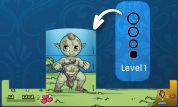
Your monster is represented by six tiles. Start with the three level-1 tiles face up above your player board, as shown. During play, you might flip some of them over to represent
that a part of your monster has achieved level 2. For level 3, replace the level 2 tile with its level 3 equivalent. You represent level 4 by flipping level 3.
GamePlay
Players take turns choosing tiles from the card row, but they do not always choose in the same order.
During the game, players’ monster figures will move clockwise around the timing track. When your figure is farthest behind, that means it is your turn to take a tile.
Turn Overview
On your turn:
-
Choose a care tile. Pay the cost by moving forward.
-
Perform the tile’s effects, if any.
-
Keep the tile in case it scores points at the end of the game.
-
Check to see if you have met one of the goals depicted on the blue goal tiles.
-
Add a new tile to the top of the row.
Cost of a Tile


The board is divided into 6 locations, as shown here.
When it is your turn, you choose one of the six tiles in the tile row. For example, the tile being taken in the illustration above costs 3.
You pay your cost by moving ahead a certain number of locations. If yours is the only figure in the new location, place it on the first rock in that location.
If there is already a figure in that location, place your figure on the first unoccupied rock and move the forbidden path marker behind the next last figure.
During the game, you will go around the board many times. No one will get lapped, because the player farthest behind always gets the next turn.
Meeting the goal tiles
Goal tiles are a reward for the first player who accomplishes a particular goal. When you take a tile that completes the goal’s requirements,
you immediately take the goal tile from the board and keep it for scoring it at the and of the game. No one else get points from that tile.
Reveal a New Tile
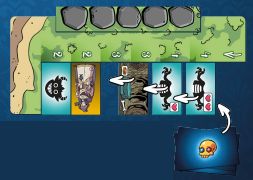
Once you have taken your tile and resolved any tile effects, your turn ends. The tile row now has one empty space. Slide tiles toward this empty space as illustrated.
Thus, some of the most expensive tiles may become a little cheaper.
This results in an empty space on the far right of the tile row. Fill this space with a new tile from the top of the deck.
Note: Unlike the setup at the start of the game, tiles are not reordered. Newest tiles are always most expensive and oldest tiles are always cheapest.
Next Player’s Turn
The next player is whoever is farthest behind on the timing track. In some cases, the same player may be able to take two turns in a row.
Taking full advantage of these opportunities is a key part of the tactics of the game.
Tiles and their effects

-
Hearts are points you score at the end of the game.
-
The illustration shows you the card’s effect.
There are several types of care tiles:
Looking After Your Monster


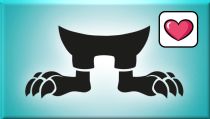
Tiles like these allow you to improve the condition of your monster, which increases the level of the body part shown. When you take an improvement tile,
increase the illustrated part of your monster by one level (by flipping or replacing the indicated body tile).
If that body part is already at level 4, the level cannot be increased, but you still may take the tile and any points it offers will be scored at the end of the game.
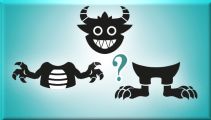
This improvement tile allows you to choose which body part gets increased by one level.
Diamonds
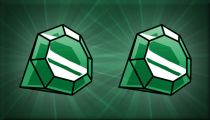
Some tiles offer you red diamonds and some offer green. For example, if you choose the tile above, take 2 green diamonds and place them near your board.
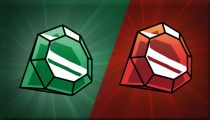
If a tile shows one of each, that means you must choose one or the other. Choosing this tile allows you to take a red diamond or a green diamond, but not both.
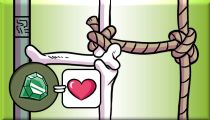
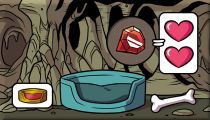
Diamonds can be assigned to certain tiles to score points at the end of the game. Each of the tiles shown here requires a diamond to get the indicated point.
The left tile requires a red diamond. The right tile requires a green diamond.
Playtime!
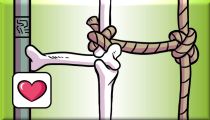
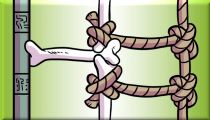
It’s always good to play with your monster. At the end of the game, you will score points based on the number of rungs in your rope ladder.
Keep playtime tiles in a column on the left side of your monster.
A Comfy Bed
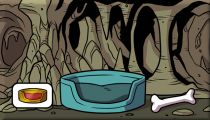
Tiles like this one help you build a comfy place for your monster to rest. This tile has one comfy bed symbol, but some tiles have two or more. You can collect as many of these tiles as you like.
Certain goal tiles and final scoring tiles care about the number of comfy bed symbols you have. Keep comfy bed tiles in two columns to the right of your monster.
Visiting the Witch Doctor
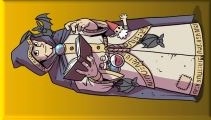
It’s good to give your monster some basic medical care. This tile will impact scoring at the end of the game, and getting more of these is better,
especially if you have taken a lot of goal tiles. Keep witch doctor tiles near the witch doctor section of your player board.
Want Tiles
The pink tiles illustrate something that your monster wants. When you take a want tile, keep it in front of you.
It may combine with your other tiles to give you points at the end of the game.
End of game
The end of the game is triggered when the last tile in the deck is dealt to the tile row. All players will get exactly one more turn.
(The player whose turn triggered the end of the game will also get one more turn.)
Players take their final turn in the order shown on the timing track, as usual. Because you will not get another turn, there is no need to pay for your last tile or to slide tiles in
the tile row. At the end of your turn, remove your monster figure from the track to show that you are done with the game.
Scoring
-
Score all hearts each player has on tiles they took.
If you have tiles that require diamonds to produce points, you assign any diamonds you collected to these tiles. Each diamond can be used on only one such tile.
If such a tile does not get its diamond, it does not score its point.
-
Score all hearts from goal tiles each player has taken.
-
Score all points from want tiles.
-
Score 3 points for each line of tiles you have built on your player board as it is indicated on the bottom right of your player board. Each line consists of one
playtime tile and two comfy bed tiles.
-
If you have witch doctor visits, multiply the number of visits by the number of blue goal tiles you collected and score that many points
(as indicated on the bottom right of your player board).
-
Score points for each of the four orange final scoring tiles. If a final scoring tile counts diamonds players collected, count diamonds that were assigned
to tiles as well as those that were not assigned.
Winning
The winner is the little monster that you worked so hard to take care of. You can send it home knowing that it will be all right now.
(Of course, the winner of the game is the player with the most points.)
During testing we discovered that the game appeals to children younger than we expected. The following modifications will make the game simpler to play:
Setup
-
Use the backside of the player boards.
-
Remove all want tiles from the deck of care tiles.
-
Do not use the orange final scoring tiles.
Scoring
If you want to keep score, use this system:
-
Players count up how much they have in each of four categories: rungs in the rope ladder, comfy bed symbols, diamonds, and witch doctor visits.
In each category, award the following points:
-
0 points if you have nothing
-
1 point if you have 1
-
2 points if you have 2
-
4 points if you have 3
-
6 points if you have 4
-
9 points if you have 5 (or more!)
-
Finally, score points for each of your monster’s three body parts:
-
4 points if it is at the 2nd level
-
8 points if it is at the 3rd level
-
12 points if it is at the 4th level
-
lose 2 points if it is still at the 1st level
Appendix
Want Tiles
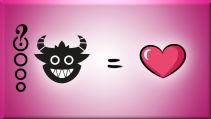
Your monster likes to be clean.
At the end of the game, you score 1 point per level for the head.
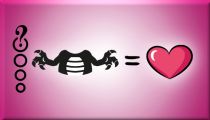
Your monster likes to be clean.
At the end of the game, you score 1 point per level for the torso.
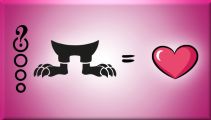
Your monster likes to be clean.
At the end of the game, you score 1 point per level for the legs.
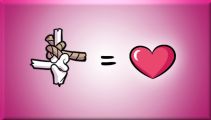
Your monster wants to play!
At the end of the game, score 1 point for each rung in your rope ladder.
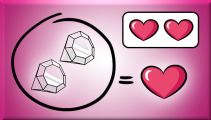
Your monster likes treasure.
At the end of the game, you score 1 point for every two diamonds you have, regardless of color.
(This tile also gives you an additional 2 points, depicted in the upper right corner.)
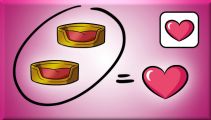
Your monster wants comfort.
At the end of the game, you score 1 point for every 2 comfy bed symbols you collected. For example, 4 or 5 bed symbols
would score 2 points. (This tile also gives you 1 additional point, depicted in the upper right corner.)
Goal Tiles

Score 2 points if your monster is the first to have its head improved to level 4.

Score 1 point if your monster is the first to have its head improved to level 3.

Score 2 points if your monster is the first to have its torso improved to level 4.

Score 3 points if your monster is the first to have its torso improved to level 4.

Score 2 points if your monster is the first to have its legs improved to level 4.

Score 1 point if your monster is the first to have its legs improved to level 3.

Score 2 points if your monster is the first to have all body parts improved to at least level 2.

Score 3 points if your monster is the first to have all body parts improved to at least level 2.

Score 2 points if your monster is the first to have all body parts improved to at least level 3.

Score 3 points if your monster is the first to have all body parts improved to at least level 3.

Score 3 points if your monster is the first to have all body parts improved to level 4.

Score 4 points if your monster is the first to have all body parts improved to level 4.

Score 2 points if you are the first player to have at least 3 rungs in your rope ladder.

Score 1 point if you are the first player to have at least 3 rungs in your rope ladder.

Score 2 points if you are the first player to have at least 4 comfy bed symbols.

Score 4 points if you are the first player to have at least 5 comfy bed symbols.

Score 1 point if your monster is the first to visit the witch doctor for a second time.

Score 2 points if your monster is the first to visit the witch doctor for a second time.

Score 2 points if you are the first player with at least one diamond of each color.

Score 3 points if you are the first player with at least one diamond of each color.
Final Scoring Tiles
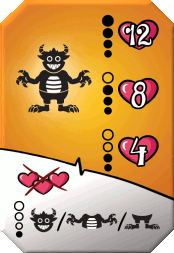
Score points according to your monster’s lowest-level body part.
If all parts are at least level 2, score 4. If at least level 3, score 8. If all parts are at level 4, score 12.
If any part is at level 1, score no points. Instead you lose 3 points for each body part at level 1.
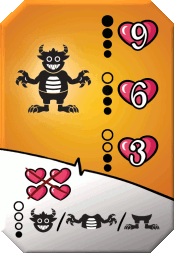
Score points according to your monster’s lowest-level body part.
If all parts are at least level 2, score 3. If at least level 3, score 6. If all parts are at level 4, score 9.
If any part is at level 1, score no points. Instead you lose 4 points for each body part at level 1.
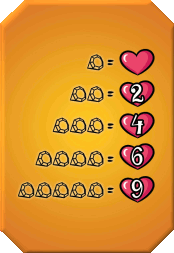
Score points according to the number of diamonds you collected during the game (ignore their colors). For example, four diamonds would be worth 6 points from this card.
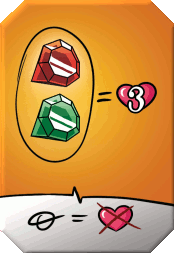
For each complementary pair of diamonds (one red, one green) you score 3 points.
If you collected no diamonds, lose 1 point.
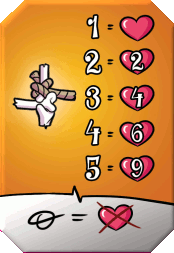
Score points according to the total number of collected rungs in your rope ladder. If you´ve got 1 rung, you get 1 point, for 2 rungs get 2 points, for 3 rungs get 4 points etc...
If you collected no rope ladders, lose 1 point.
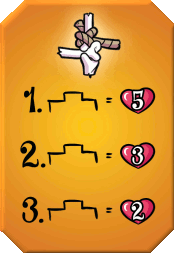
Score points based on how many knots you collected, relative to the other players. The player who collected the most gets 5 points, second most gets 3, third most gets 2.
In case of ties, add the points, divide evenly, and ignore the remainder.
Players with no knots are not allowed to get points from this tile.
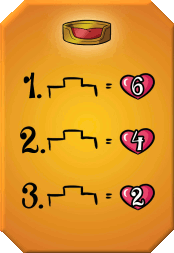
Score points based on how many comfy bed symbols you collected, relative to the other players. The player who collected the most gets 6 points, second most gets 4, third most gets 2.
In case of ties, add the points, divide evenly, and ignore the remainder.
Players with no comfy bed symbols are not allowed to get points from this tile.
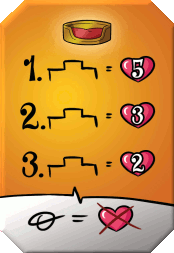
Score points based on how many comfy bed symbols you collected, relative to the other players. The player who collected the most gets 5 points, second most gets 3, third most gets 2.
In case of ties, add the points, divide evenly, and ignore the remainder.
Players with no comfy bed symbols lose 1 point.
It is possible to hide the player boards containing the monster babies when clicking on the little icon depicting the monster baby's head in the player overview. A hidden player board
can be made visible in the same way.
Per default the player's own player board and all player boards in a 2-player game will be visible when the game window is opened. This behaviour can be changed in the settings.
Since all those monster babies are really cute, the monster babies will per default be distributed randomly, so you can play with different monster babies in different games.
If all players choose the setting 'random monster baby' the distribution will be the same for every player, i.e. if player 1 has the little dragon baby, all players with that setting
will see player 1 taking care of a dragon baby.
If you prefer to play with your favourite monster, just uncheck the checkbox 'random monster baby' in the settings. After that you will always play
with the same monster baby. You can choose your monster baby in the settings dialog.
For rungs and comfy beds the number of according care tiles is given in parenthesis, so you can easily calculate the number of completed lines relevant for scoring.
Playing the simplified game completed lines are not scored and therefore the number of care tiles of that type is not displayed.
Clicking on the topmost caretile (depicted with the backside), the remaining care tiles in the draw pile will be presented in a popup. The number on that care tile shows the number of
remaining care tiles in the draw pile.
The backside of a care tile is also depicted at the bottom of the player boards. Clicking on that one will open a popup with all the care tiles this player has already taken.
If the player board is currently hidden for that player, just click on the monster icon in the top left of the player overview to show the player board as described above.
If a player has collected care tiles which get you points only if you assign a diamond, these diamonds will be assigned automatically to provide the maximum of points.
The player overview displays the number of diamonds held. If this is followed by a red number in parentheses, this is the number of additional diamonds required to complete the care tiles the player holds.
You can have a look at the goal tiles of a player when clicking on the empty goal tile depicted right above the monster baby's head. The number on that empty goal tile indicates the
number of goal tiles a player has already collected.
If the player board is hidden, this info is available as small icon in the player overview. Clicking on that will open the same popup with all goal tiles.